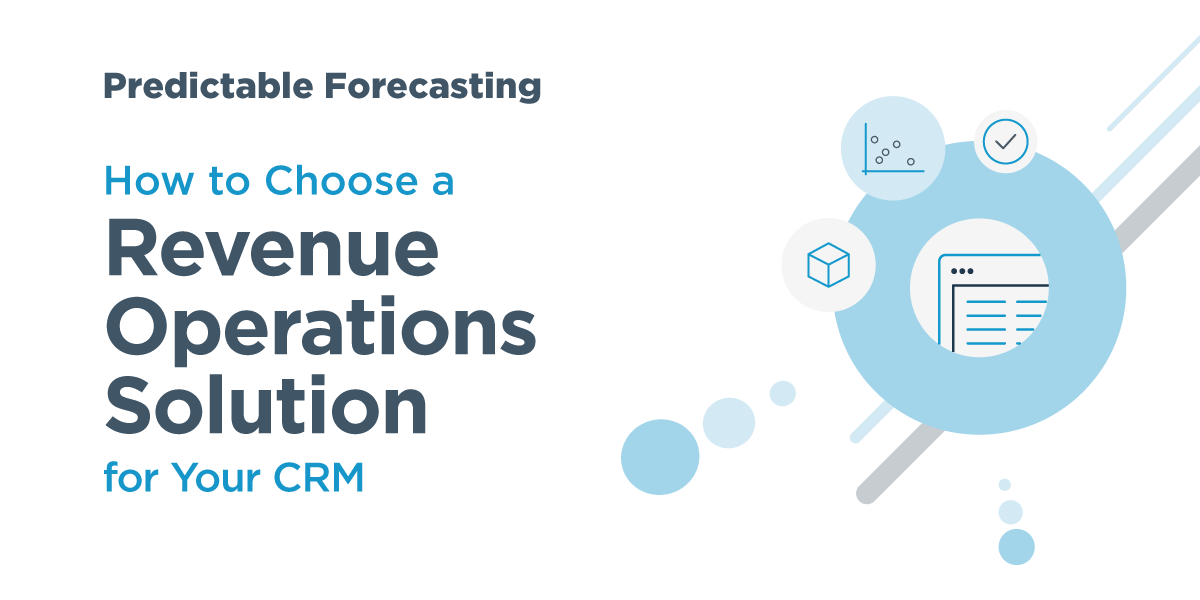The goal of your entire go-to-market team — whether you're a sales rep, frontline manager, marketer, customer success manager, or revenue operations leader — is to drive predictable revenue for your business.
Yet, very few go-to-market teams can align around their revenue goals and are often siloed in their forecast calls and spreadsheets. There is no single source of truth for their deal activity, so revenue teams have to guess historical trends and cobble together a prediction.
Modern revenue teams are no longer running their revenue process through a hodgepodge of spreadsheets and business intelligence reports. They're modernizing their process with a revenue operations solution that allows them not only to quickly identify their forecast risk and upside, but also generate higher sales forecast accuracy and alignment.
A revenue operations solution can be customized to align with how you run your business and your sales forecasting process, allowing you to appropriately view, track, or update your current quarter and out-quarter predictions. Additionally, you and your team can easily collaborate to update your number based on real-time deal data, historical trends, and predictive insights.
In parts 1, 2 and 3 of our RevOps buyer's guide series, we specified the critical components that every revenue operations solution should have:
- Trustworthy data and automation;
- Deeper revenue insights;
- Consistent execution;
- Predictable revenue.
We started with trustworthy deal data that is transformational for your CRM data quality and dove into the importance of deeper, actionable revenue insights and how to drive consistent execution.
In part 4 of our RevOps buyer’s guide blog series, we will walk you through why predictable forecasting matters — and how to find a revenue operations solution to get you there.
Revenue Operations Solutions to the Rescue
First things first: a little background on the importance of a revenue operations solution. A RevOps solution gives you real-time visibility into your deals, as well as broad accessibility so anyone on the revenue operations team (and beyond) can see the engagement and activity levels of all deals. Revenue operations solutions use AI to analyze historical deal trends and patterns, so you know which deals are at risk, where to focus, and ultimately where you will land this quarter and next. You no longer need to wait around for someone else to build a report — it's all right there in one place.
Adding an AI-based revenue operations solution to your CRM is the way modern sales teams improve their data hygiene, save time, and replace the hodgepodge of untrustworthy spreadsheets and stale reports. With one unified system, revenue operations teams can align around the same numbers and predict revenue more effectively.
Why Is Predictable Forecasting Important in a RevOps Solution?
The ability to predict revenue sets the pulse for the entire company. It allows you to properly align the operating budget with the operating plan so you can invest and grow with confidence.
To drive predictability in your forecast, your team has to get out of spreadsheets and ad-hoc reporting. Your forecast roll-up process must be automated and efficient to save time for all key stakeholders. Additionally, your business should be able to forecast across all revenue dimensions, including renewals, product lines, territories, etc., to provide the most accurate view of your business.
How Can You Evaluate a RevOps Solution for Predictable Forecasting?
So what exactly should you be looking for in a revenue operations solution?
- Determine whether the system is flexible enough to fit your sales process and forecasting approach, and assess how easily it can adapt to future changes in your business.
- See if the solution can forecast not just net new opportunities, but also churn and upsell opportunities, as well as other revenue dimensions.
Key Predictable Forecasting Features to Look for in a RevOps Solution
We've compiled a list of critical capabilities every revenue operations solution should include.
- Real-time integration with CRM: the ability to present real-time CRM data in forecasting views so you're always making decisions based on up-to-date information.
- Forecast history tracking: the ability to track individual changes to forecast updates so you are illuminating patterns and trends for better predictability.
- Flexible forecast architecture: the ability to roll up forecasts against product line items, revenue schedules, quantities, splits, and custom objects so you can flexibly forecast based on the way you run your business.
- Forecast time period customization: the ability to set quarterly, monthly, and weekly fields for submission.
- Support for multiple forecasts: the ability to create multiple forecasts for different business segments so various teams can flexibly forecast based on the way they run their business units.
- Support for forecast aggregation: the ability to aggregate forecasts across multiple parallel forecasts, so different teams can run their forecasts without additional noise from other teams.
- Aggregation of monthly forecasts into quarterly forecasts: the ability to combine forecast values from months into a quarter.
- Forecast KPIs: the ability to display forecast KPIs such as coverage ratio, pipeline generation, gap to quota, gap to closed, etc., so you can see the live status of your KPIs at a glance.
- Forecast submission: the flexibility for reps/managers/executives to enter forecast updates, overrides, and notes.
- Integration with deal-level insights: the ability to see AI-generated opportunity score and all activity associated with the opportunity so you can dig into the details of the forecast.
- Opportunity-level overrides: the ability for managers to override individual opportunities in and out of the forecast so you can run the best-case and worst-case scenarios.
- Mobile forecasting: the ability for reps/managers/executives to submit updates to their forecast via mobile device so it's always up to date.
- Update cadence configurability: the ability to set compliance with forecast submission periods.
- Current quarter/month projection: the ability to provide an AI-generated projection for the current quarter/month based on past quarter history, so you can gut check your call with data science.
- Historical, side-by-side comparisons of the AI projection, pipeline, and forecast call: Ability to display the historical trends of an AI projection next to the pipeline and manually inputted forecast
- Next quarter projection: the ability to display the historical trends of an AI projection next to the pipeline and manual forecast so you can uncover potential risk and patterns.
- Suggested pipeline coverage for future quarters: an AI-generated pipeline coverage suggestion for future quarters.
Modernizing your revenue process shouldn't be hard. With a revenue operations solution, you can drastically transform the way you drive revenue growth and retention for your business.
To maximize the benefits of your RevOps solution and achieve even more predictable revenue, implement a revenue operations framework.
To uncover more must-have capabilities to select the right AI-based RevOps solution for your business, download our ebook "How to Choose a Revenue Operations Solution for your CRM" and supercharge your revenue process today.


